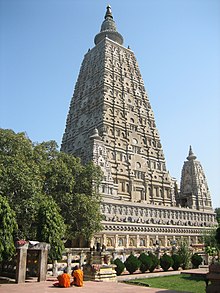Mahabodhi Temple Complex
| Mahabodhi Temple Complex at Bodh Gaya बोध गया का महाबोधि मंदिर परिसर |
|
|---|---|
| Name as inscribed on the World Heritage List | |

Mahabodhi Temple
|
|
| Type | Cultural, Religious |
| Criteria | (i)(ii)(iii)(iv)(vi) |
| Reference | 1056 |
| UNESCO region | Asia-Pacific |
| Coordinates | 24°41′46″N 84°59′29″E / 24.696004°N 84.991358°ECoordinates: 24°41′46″N 84°59′29″E / 24.696004°N 84.991358°E |
| Inscription history | |
| Inscription | 2002 (26th Session) |
The Mahabodhi Vihar (महाबोधि विहार) (literally: "Great Awakening Temple"), a UNESCO World Heritage Site, is a Buddhist temple in Bodh Gaya, marking the location where the Buddha is said to have attained enlightenment. Bodh Gaya (in Gaya district) is about 96 km (60 mi) from Patna, Bihar state, India.
Depictions at the site include Avalokiteśvara (Padmapani, Khasarpana), Vajrapani, Tara, Marichi, Yamantaka, Jambhala and Vajravārāhī. Images of Vishnu, Shiva, Surya and other Vedic deities are also associated with the site.
The site contains a descendant of the Bodhi Tree under which Buddha gained enlightenment.
Traditional accounts say that, around 589 BCE, Siddhartha Gautama, a young prince who saw the suffering of the world and wanted to end it, reached the forested banks of the Phalgu river, near the city of Gaya, India. There he sat in meditation under a peepul tree (Ficus religiosa or Sacred Fig) which later became known as the Bodhi tree. According to Buddhist scriptures, after three days and three nights, Siddharta attained enlightenment and the answers that he had sought. In that location, Mahabodhi Temple was built by Emperor Ashoka in around 260 BCE.
...
Wikipedia

